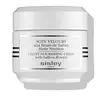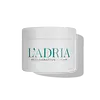What's inside
What's inside
 Key Ingredients
Key Ingredients

 Benefits
Benefits

 Concerns
Concerns

 Ingredients Side-by-side
Ingredients Side-by-side

Water
Skin ConditioningPropylheptyl Caprylate
EmollientGlycerin
HumectantMacadamia Integrifolia Seed Oil
Skin ConditioningCetearyl Alcohol
EmollientButylene Glycol
HumectantButyrospermum Parkii Butter
Skin ConditioningSqualane
EmollientGossypium Herbaceum Seed Oil
Skin ConditioningHelianthus Annuus Seed Oil
EmollientGlyceryl Stearate Citrate
EmollientCetearyl Glucoside
EmulsifyingSaccharide Isomerate
HumectantPanthenol
Skin ConditioningTocopheryl Acetate
AntioxidantOphiopogon Japonicus Root Extract
Skin ConditioningCrocus Sativus Flower Extract
MaskingPolygonum Fagopyrum Seed Extract
Skin ConditioningTocopherol
AntioxidantPadina Pavonica Thallus Extract
Skin ConditioningSimmondsia Chinensis Seed Oil
EmollientCetyl Alcohol
EmollientPropanediol
SolventEthylhexylglycerin
Skin ConditioningHydroxypropyl Starch Phosphate
Hydroxyethyl Acrylate/Sodium Acryloyldimethyl Taurate Copolymer
Emulsion StabilisingGlycine Soja Oil
EmollientCitric Acid
BufferingPolysorbate 60
EmulsifyingSorbitan Isostearate
EmulsifyingSodium Citrate
BufferingSodium Hydroxide
BufferingParfum
MaskingPhenoxyethanol
PreservativeSodium Benzoate
MaskingPotassium Sorbate
PreservativeGeraniol
PerfumingCitronellol
PerfumingWater, Propylheptyl Caprylate, Glycerin, Macadamia Integrifolia Seed Oil, Cetearyl Alcohol, Butylene Glycol, Butyrospermum Parkii Butter, Squalane, Gossypium Herbaceum Seed Oil, Helianthus Annuus Seed Oil, Glyceryl Stearate Citrate, Cetearyl Glucoside, Saccharide Isomerate, Panthenol, Tocopheryl Acetate, Ophiopogon Japonicus Root Extract, Crocus Sativus Flower Extract, Polygonum Fagopyrum Seed Extract, Tocopherol, Padina Pavonica Thallus Extract, Simmondsia Chinensis Seed Oil, Cetyl Alcohol, Propanediol, Ethylhexylglycerin, Hydroxypropyl Starch Phosphate, Hydroxyethyl Acrylate/Sodium Acryloyldimethyl Taurate Copolymer, Glycine Soja Oil, Citric Acid, Polysorbate 60, Sorbitan Isostearate, Sodium Citrate, Sodium Hydroxide, Parfum, Phenoxyethanol, Sodium Benzoate, Potassium Sorbate, Geraniol, Citronellol
Water
Skin ConditioningButyrospermum Parkii Butter
Skin ConditioningCaprylic/Capric/Succinic Triglyceride
EmollientPentylene Glycol
Skin ConditioningBetaine
HumectantCoco-Caprylate
EmollientCaprylic/Capric Triglyceride
MaskingGlyceryl Stearate Citrate
EmollientUndecane
EmollientDipalmitoyl Hydroxyproline
Skin ConditioningAlgae Extract
EmollientArachidyl Alcohol
EmollientSoluble Collagen
HumectantGlyceryl Stearate
EmollientTridecane
PerfumingBehenyl Alcohol
EmollientTocopheryl Acetate
AntioxidantArachidyl Glucoside
EmulsifyingCarnosine
Skin ConditioningTocopherol
AntioxidantXanthan Gum
EmulsifyingAdenosine
Skin ConditioningAllantoin
Skin ConditioningSodium Hyaluronate
HumectantSodium Phytate
Citric Acid
BufferingSodium Benzoate
MaskingPotassium Sorbate
PreservativeWater, Butyrospermum Parkii Butter, Caprylic/Capric/Succinic Triglyceride, Pentylene Glycol, Betaine, Coco-Caprylate, Caprylic/Capric Triglyceride, Glyceryl Stearate Citrate, Undecane, Dipalmitoyl Hydroxyproline, Algae Extract, Arachidyl Alcohol, Soluble Collagen, Glyceryl Stearate, Tridecane, Behenyl Alcohol, Tocopheryl Acetate, Arachidyl Glucoside, Carnosine, Tocopherol, Xanthan Gum, Adenosine, Allantoin, Sodium Hyaluronate, Sodium Phytate, Citric Acid, Sodium Benzoate, Potassium Sorbate
 Reviews
Reviews

Ingredients Explained
These ingredients are found in both products.
Ingredients higher up in an ingredient list are typically present in a larger amount.
This ingredient is also known as shea butter. It is an effective skin hydrator and emollient.
Emollients help soothe and soften your skin. It does this by creating a protective film on your skin. This barrier helps trap moisture and keeps your skin hydrated. Emollients may be effective at treating dry or itchy skin.
Shea butter is rich in antioxidants. Antioxidants help fight free-radicals, or molecules that may harm the body. It is also full of fatty acids including stearic acid and linoleic acid. These acids help replenish the skin and keep skin moisturized.
While Shea Butter has an SPF rating of about 3-4, it is not a sunscreen replacement.
Shea butter may not be fungal acne safe. We recommend speaking with a professional if you have any concerns.
Learn more about Butyrospermum Parkii ButterCitric Acid is an alpha hydroxy acid (AHA) naturally found in citrus fruits like oranges, lemons, and limes.
Like other AHAs, citric acid can exfoliate skin by breaking down the bonds that hold dead skin cells together. This helps reveal smoother and brighter skin underneath.
However, this exfoliating effect only happens at high concentrations (20%) which can be hard to find in cosmetic products.
Due to this, citric acid is usually included in small amounts as a pH adjuster. This helps keep products slightly more acidic and compatible with skin's natural pH.
In skincare formulas, citric acid can:
While it can provide some skin benefits, research shows lactic acid and glycolic acid are generally more effective and less irritating exfoliants.
Most citric acid used in skincare today is made by fermenting sugars (usually from molasses). This synthetic version is identical to the natural citrus form but easier to stabilize and use in formulations.
Read more about some other popular AHA's here:
Learn more about Citric AcidGlyceryl Stearate Citrate is a citric acid ester of glyceryl stearate.
It is an emulsifier, emollient, and a surfactant.
Emulsifiers help stabilize a product. It does this by preventing certain ingredients from separating. Common ingredients include oils and water, which do not mix naturally. Emulsifiers have properties that help keep ingredients such as these together.
Emollients help soothe and soften the skin. They do this by creating a protective film on your skin. This barrier helps trap moisture and keeps your skin hydrated. Emollients may be effective at treating dry or itchy skin.
Surfactants help gather oils, dirt, and other pollutants from the skin. This helps them to be easily rinsed away.
Learn more about Glyceryl Stearate CitratePotassium Sorbate is a preservative used to prevent yeast and mold in products. It is commonly found in both cosmetic and food products.
This ingredient comes from potassium salt derived from sorbic acid. Sorbic acid is a natural antibiotic and effective against fungus.
Both potassium sorbate and sorbic acid can be found in baked goods, cheeses, dried meats, dried fruit, ice cream, pickles, wine, yogurt, and more.
You'll often find this ingredient used with other preservatives.
Learn more about Potassium SorbateSodium Benzoate is a preservative. It's used in both cosmetic and food products to inhibit the growth of mold and bacteria. It is typically produced synthetically.
Both the US FDA and EU Health Committee have approved the use of sodium benzoate. In the US, levels of 0.1% (of the total product) are allowed.
Sodium benzoate works as a preservative by inhibiting the growth of bacteria inside of cells. It prevents the cell from fermenting a type of sugar using an enzyme called phosphofructokinase.
It is the salt of benzoic acid. Foods containing sodium benzoate include soda, salad dressings, condiments, fruit juices, wines, and snack foods.
Studies for using ascorbic acid and sodium benzoate in cosmetics are lacking, especially in skincare routines with multiple steps.
We always recommend speaking with a professional, such as a dermatologist, if you have any concerns.
Learn more about Sodium BenzoateTocopherol (also known as Vitamin E) is a common antioxidant used to help protect the skin from free-radicals and strengthen the skin barrier. It's also fat soluble - this means our skin is great at absorbing it.
Vitamin E also helps keep your natural skin lipids healthy. Your lipid skin barrier naturally consists of lipids, ceramides, and fatty acids. Vitamin E offers extra protection for your skin’s lipid barrier, keeping your skin healthy and nourished.
Another benefit is a bit of UV protection. Vitamin E helps reduce the damage caused by UVB rays. (It should not replace your sunscreen). Combining it with Vitamin C can decrease sunburned cells and hyperpigmentation after UV exposure.
You might have noticed Vitamin E + C often paired together. This is because it is great at stabilizing Vitamin C. Using the two together helps increase the effectiveness of both ingredients.
There are often claims that Vitamin E can reduce/prevent scarring, but these claims haven't been confirmed by scientific research.
Learn more about TocopherolTocopheryl Acetate is AKA Vitamin E. It is an antioxidant and protects your skin from free radicals. Free radicals damage the skin by breaking down collagen.
One study found using Tocopheryl Acetate with Vitamin C decreased the number of sunburned cells.
Tocopheryl Acetate is commonly found in both skincare and dietary supplements.
Learn more about Tocopheryl AcetateWater. It's the most common cosmetic ingredient of all. You'll usually see it at the top of ingredient lists, meaning that it makes up the largest part of the product.
So why is it so popular? Water most often acts as a solvent - this means that it helps dissolve other ingredients into the formulation.
You'll also recognize water as that liquid we all need to stay alive. If you see this, drink a glass of water. Stay hydrated!
Learn more about Water